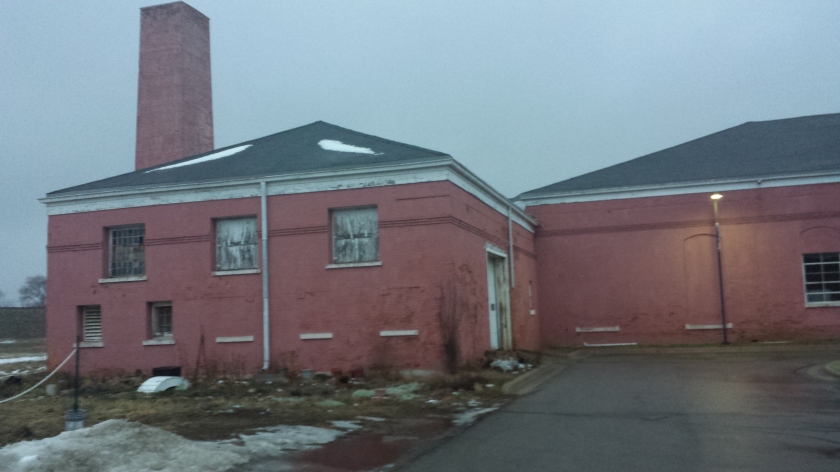From Indentured Servants and Prison Laborers, to Wage Slaves and Starving Artists
by Evan Farmer
Consider the historical record of the ghosts who live at the building on N. Mechanic Street that now houses Art 634. Often times I’ve wondered how many poltergeists wander the old wooden floors of the back gallery, and what variety of tortured ancient souls pass between the planes of existence before me. Their stories would lead us into the lives of men, young and old, who were bought and sold into the injustice of forced prison labor. The brutal and cold system of corrections that was simultaneously birthed next door to the shops at the 600 block of North Mechanic produced a workforce of demented and diseased state enslaved servants who made binder twine, wagon wheels, and farm implements, among other things.
Today, the old Michigan State Prison has been re-purposed and made into housing for creative folks of all sorts. And there are still bars on the windows of the ground level studio spaces that have been set aside for the artists who now live in the Armory Artswalk Apartments. Though some may be “starving artists,” none have been forced to work on the chain gang, and in place of the manufacturing companies that were right next door, a collection of arts oriented shops and studios have been born. Art 634 has been building a new industry built on art and ingenuity, free enterprise and creativity. In place of the opportunistic spirit of nineteenth century industrialization, a community of artistic entrepreneurs has blossomed.
Throughout the mid to late 1800s, convicts from the State Prison were employed by early Jackson manufacturers such as Pinney, Connable & Company, which later became the Withington & Cooley Company, until the 1930’s when Acme Industries moved in. The prisoners were paid a measly wage, somewhere around thirty to fifty cents a day, and were incarcerated under the deplorable “Auburn” style prison system, where they were forced into hard labor, subjected to the ball and chain and the lash, and lived amidst generally harsh conditions in a chronically overcrowded facility. The prison laborers received none of the wages they worked for, though the industries they worked so hard to help build, and the capitalists who established them, benefited greatly.
In this way, the “contract” labor of our state’s first prison system effectively continued the American tradition of indentured servitude. In all likelihood, many of those who were housed at the prison and worked in the North Mechanic Street shops, were descendants of former slaves who were born into a life of abject poverty and were nearly forced into a life of crime. By extension, that institution has continued even to this day, through the wage slave jobs provided by modern factories, and now huge multinational corporations such as McDonald’s and Wal-Mart. No doubt, there are numerous families who live in Jackson today who have been essentially kept imprisoned and enslaved by the legacy of slavery and prison labor, which has continued the tradition of low paying jobs that cannot provide a basic living wage for many ex-convict employees and other uneducated workers.
The heritage of our past can be a difficult pattern to break away from. The reverberations of historical injustices can resonate even through the present, if we are unable to reconcile and heal the collective memory we share of that oppression and pain. Art 634 has begun the curative work of transforming this place in Jackson that was once the cold, dark heart of our city. Through drawing, painting, dance, music, and other fine arts, we can facilitate the process of healing by projecting a more positive focus of energy into the spaces we inhabit. And hopefully the ghosts that we encounter amongst these artistic endeavors will be inspired to release that pain, and be liberated from the negative experiences that keep haunting them and continue lingering in the present.
http://www.michigan.gov/msi/0,4642,7-174-23878-65447–,00.html
http://blog.mlive.com/citpat_history/2007/10/prison_was_industrial_center.html
Armory Arts Village Began With a Flourish, Primed for a Great Future
by Rod Malloy
Armory Arts Village began as a community redevelopment project with broad local leadership support and a vision to transform National Guard Armory and historic State Prison buildings into a Village with Artswalk Apartments. The dream became a reality in 2006 and Ann Arbor architects Quinn Evans received the 2006 Michigan State award for most innovative renovation of a historic building for the project.
http://www.quinnevans.com/portfolio/neighborhoods-communities/armory-arts-village
Quinn Evans’ website describes Armory Arts Village:
In a city long known for its blue-collar manufacturing industry and prison, QEA is playing a central role in cultural and economic revitalization. We led the adaptation of three historic prison buildings (more recently re-purposed as a National Guard Armory), to create an arts neighborhood with 62 affordable live/work lofts. In addition, the structures feature shared workspace for resident performing and visual artists, artisans and designers, including a two-story industrial arts production space, studios, as well as first-floor galleries, a coffee shop and retail space.
The 62 apartment units housed 40 artists in the beginning, today among the 62 apartment residents, only 10 artists call 100 Armory Court home. The Armory Arts Community seeks younger artists, and actively pursues opportunities to promote the community and to bring back Jackson Journey Tours and the two-story gallery space.
Two other buildings are included in the Armory Arts Village complex. A pink building added by the National Guard houses the local bike rehab project. Louis Cubille started the bike repair project at Art 634 as an after school program 12 years ago. Louis’ studio was in the current Cuppa Coffee Company location. The other building located behind the apartments building and inside the historic prison wall is the State Prison mess hall building. In the 1970s the community rallied to protect the prison wall against forces wanting to tear it down.













